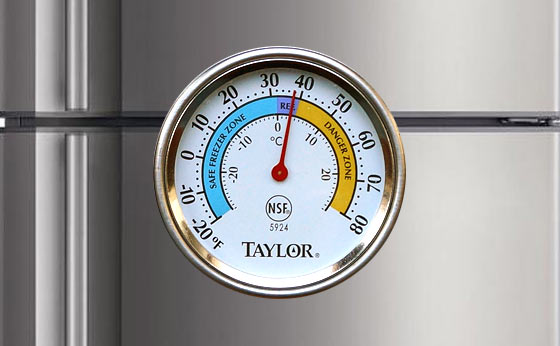Safe Food Storage Time In The Refrigerator

A refrigerator is one of the most important pieces of equipment in the kitchen for keeping foods safe. Refrigeration slows bacterial growth.
Bacteria grow most rapidly between 40 and 140 °F, the “Danger Zone”.
A refrigerator set at 40 °F or below will protect most foods.
If you’re wondering how long food storage will last in the refrigerator, here’s a list of common foods and their safe food storage time in the fridge.
Storage Times For Refrigerated Foods
Ground Meat, Ground Poultry, and Stew Meat |
|
|---|---|
| Ground beef, turkey, veal, pork, lamb | 1-2 days |
| Stew meats | 1-2 days |
Fresh Meat (Beef, Veal, Lamb, and Pork) |
|
| Steaks, chops, roasts | 3-5 days |
Fresh Poultry |
|
| Chicken or turkey, whole | 1-2 days |
| Chicken or turkey, parts | 1-2 days |
| Giblets | 1-2 days |
Bacon and Sausage |
|
| Bacon | 7 days |
| Sausage, raw from meat or poultry | 1-2 days |
| Smoked breakfast links, patties | 7 days |
| Summer sausage labeled “Keep Refrigerated” | Opened, 3 weeks |
| Hard sausage (such as Pepperoni) | 2-3 weeks |
Ham, Corned Beef |
|
| Ham, canned, labeled “Keep Refrigerated” | Opened, 3-5 days |
| Ham, fully cooked, whole | 7 days |
| Ham, fully cooked, half | 3-5 days |
| Ham, fully cooked, slices | 3-4 days |
| Corned beef in pouch with pickling juices | 5-7 days |
Hot Dogs and Luncheon Meats |
|
| Hot dogs | Opened package, 1 week |
| Luncheon meats | Opened package, 3-5 days |
Deli and Vacuum-Packed Products |
|
| Store-prepared (or homemade) egg, chicken, tuna, ham, and macaroni salads | 3-5 days |
| Pre-stuffed pork, lamb chops, and chicken breasts | 1 day |
| Store-cooked dinners and entrees | 3-4 days |
| Commercial brand vacuum-packed dinners | unopened, 2 weeks |
Cooked Meat, Poultry, and Fish Leftovers |
|
| Pieces and cooked casseroles | 3-4 days |
| Gravy and broth, patties, and nuggets | 3-4 days |
| Soups and Stews | 3-4 days |
Fresh Fish and Shellfish |
|
| Fresh Fish and Shellfish | 1-2 days |
Eggs |
|
| Fresh, in shell | 3-5 weeks |
| Raw yolks, whites | 2-4 days |
| Hard-cooked | 1 week |
| Liquid pasteurized eggs, egg substitutes | Opened, 3 days |
| Cooked egg dishes | 3-4 days |
Data source: United States Department of Agriculture; Food Safety and Inspection Service
Opinion: The times listed above appear to be conservative and erring on the side of caution, and your own experience ‘may’ exhibit slightly longer safe food storage times. Having said that, a fridge temperature less than 40-degrees-F will assure the safest and longest food storage.
Types of Bacteria in Refrigerated Foods
There are two completely different families of bacteria: pathogenic bacteria, the kind that cause foodborne illness, and spoilage bacteria, the kind of bacteria that cause foods to deteriorate and develop unpleasant odors, tastes, and textures.
Pathogenic bacteria can grow rapidly in the “Danger Zone,” the temperature range between 40 and 140 °F, but they do not generally affect the taste, smell, or appearance of a food. In other words, one cannot tell that a pathogen is present.
Spoilage bacteria can grow at low temperatures, such as in the refrigerator. Eventually they cause food to develop off or bad tastes and smells. Most people would not choose to eat spoiled food, but if they did, they probably would not get sick. It comes down to an issue of quality versus safety:
Food that has been left too long on the counter may be dangerous to eat, but could look fine.
Safe Refrigerator Temperature
For safety, it is important to verify the temperature of the refrigerator.
Refrigerators should be set to maintain a temperature of 40 °F or below.
